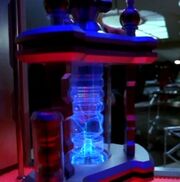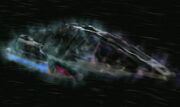(+see alsos) |
(expanded a bit, image relocation) |
||
| Line 1: | Line 1: | ||
| − | [[File:Coaxial warp drive.jpg|thumb|A coaxial |
+ | [[File:Coaxial warp drive.jpg|thumb|A coaxial induction drive.]] |
| + | A '''coaxial warp drive''' was a [[propulsion]] system hypothesized by [[Starfleet]] [[engineer]]s in the [[24th century]], with the theoretic capability of folding the fabric of [[space]], allowing a ship to travel instantaneously across extremely large distances. |
||
| ⚫ | |||
| − | A '''coaxial warp drive''' (also known as a '''coaxial induction drive''' or a '''differential induction drive''') is a [[propulsion]] system that folds [[space]] in on itself, allowing instantaneous travel over huge distances. |
||
| + | Such a propulsion system was encountered in the [[Delta Quadrant]] by the crew of the {{USS|Voyager}} in [[2374]], when they came across [[Coaxial warp ship|a ship]] piloted by a [[Benthan]] named [[Steth]]. Emerging from coaxial space in an unstable condition, the vessel threatened to explode and collapse space within a radius of a billion kilometers. Such a catastrophe was averted, however, when [[Tom Paris]], ''Voyager''{{'}}s [[helmsman]], managed to generate a [[symmetric warp field]] around Steth's ship, containing the instabilities in the space-folding core. |
||
| − | In the [[24th century]], it was believed by [[Starfleet]] [[scientist]]s and [[engineer]]s to be a purely hypothetical technology. However, a functioning [[coaxial warp ship]] was encountered by the [[Federation]] [[starship]] {{USS|Voyager}} in [[2374]]. The ship originated on [[Benthos]], and was piloted by an [[Steth (impostor)|impostor]] posing as [[Steth]]. |
||
| ⚫ | The coaxial induction drive functioned by drawing in [[subatomic particle]]s and reconfiguring their internal geometries. The drive was imperfect, however, as particle instabilities tended to overload the engines. To correct for this flaw, Paris conceived of the idea of using a [[polaric modulator]] to dilute the particle stream as it entered the coaxial core, drawing inspiration from a [[20th century]] device known as a [[carburetor]]. |
||
| − | The ship was experimental and unstable when it emerged from warp, threatening to explode with the theoretical possibility of collapsing space within a radius of a billion kilometers. [[Lieutenant]] [[Tom Paris]] suggested a [[symmetric warp field]] to contain any instabilities in its space-folding core, averting the explosion. |
||
| ⚫ | |||
| ⚫ | The coaxial |
||
| + | The ''Voyager'' crew eventually discovered that Steth was, in fact, [[Steth (impostor)|an imposter]] who has the literal ability to switch his [[DNA]] with another individual, in essence switching bodies. When this lifeform switched places with [[Captain]] [[Kathryn Janeway|Janeway]], he attempted to escape from ''Voyager'' using a [[shuttle]] which had been modified with coaxial warp drive. Paris was able to prevent his escape, however, by targeting the polaric modulator with a [[chromoelectric pulse]], disrupting his engines. ''Voyager''{{'}}s [[The Doctor|doctor]] was subsequently able to restore Paris and Janeway to their original bodies. ({{VOY|Vis à Vis}}) |
||
| − | |||
| − | [[Seven of Nine]] began working on a way to modify a [[shuttlecraft]] to go to coaxial warp, but the ship never made it after Tom and the real Steth disabled the polaric modulator with a [[chromoelectric pulse]]. ({{VOY|Vis à Vis}}) |
||
{{bginfo|In a {{y|2009}} statement, [[Doug Drexler]] stated the spindly [[nacelle]] struts on [[26th century]] {{USS|Enterprise|NCC-1701-J|-J}} were intended to suggest a warp drive that can fold space. [http://drexfiles.wordpress.com/2009/02/16/enterprise-j-search/]}} |
{{bginfo|In a {{y|2009}} statement, [[Doug Drexler]] stated the spindly [[nacelle]] struts on [[26th century]] {{USS|Enterprise|NCC-1701-J|-J}} were intended to suggest a warp drive that can fold space. [http://drexfiles.wordpress.com/2009/02/16/enterprise-j-search/]}} |
||
Revision as of 22:00, 9 November 2010

A coaxial induction drive.
A coaxial warp drive was a propulsion system hypothesized by Starfleet engineers in the 24th century, with the theoretic capability of folding the fabric of space, allowing a ship to travel instantaneously across extremely large distances.
Such a propulsion system was encountered in the Delta Quadrant by the crew of the USS Voyager in 2374, when they came across a ship piloted by a Benthan named Steth. Emerging from coaxial space in an unstable condition, the vessel threatened to explode and collapse space within a radius of a billion kilometers. Such a catastrophe was averted, however, when Tom Paris, Voyager's helmsman, managed to generate a symmetric warp field around Steth's ship, containing the instabilities in the space-folding core.
The coaxial induction drive functioned by drawing in subatomic particles and reconfiguring their internal geometries. The drive was imperfect, however, as particle instabilities tended to overload the engines. To correct for this flaw, Paris conceived of the idea of using a polaric modulator to dilute the particle stream as it entered the coaxial core, drawing inspiration from a 20th century device known as a carburetor.

A Starfleet shuttlecraft going to coaxial warp.
The Voyager crew eventually discovered that Steth was, in fact, an imposter who has the literal ability to switch his DNA with another individual, in essence switching bodies. When this lifeform switched places with Captain Janeway, he attempted to escape from Voyager using a shuttle which had been modified with coaxial warp drive. Paris was able to prevent his escape, however, by targeting the polaric modulator with a chromoelectric pulse, disrupting his engines. Voyager's doctor was subsequently able to restore Paris and Janeway to their original bodies. (VOY: "Vis à Vis")
